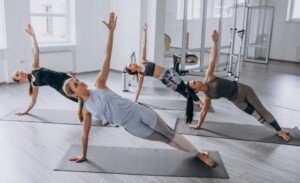
Yoga is a great way to do strength tests if you’re convinced you have ALS due to twitching muscles.
Many people, who can’t help but think of ALS because their muscles have been twitching lately, do not have a structured exercise regimen in place.
So they conduct strength tests around the house, such as repeatedly standing on one leg, running up stairs, lifting one end of a sofa, unscrewing tight jar lids, repeatedly placing the bowling ball on a high shelf, etc.
It can become overwhelming, highly stressful and … a nuisance to measure if there’s any progress in strength (e.g., is lifting the bowling ball onto the top closet shelf easier than it was last week??).
Yoga for Twitching Muscle ALS Fear
This is where yoga comes in. When you take yoga for the first time, you will realize that the poses are more difficult than they look.
At the end of the class, you will know which type of poses are the most troublesome for your degree of fitness.

Source: Freepik.com/senivpetro
Many of the poses involve balancing on one foot. Other poses require a unique kind of strength that is not required to lift heavy barbells.
If you’re healthy, you will notice progress in your ability to practice yoga as you take classes over time.
If you’re already fit from working out, your progress in yoga will be faster.
If you practice some poses at home in between class sessions, you’ll get better even faster.
If you have time, take two yoga classes a week and see whether or not you progress. Or regress!
If you find that you’re progressing with your yoga poses, that they come easier to you, that you’re able to go deeper into them or take on more difficult versions of them … this should eliminate your anxiety that your twitching muscles are being caused by ALS.
If you have dying neurons, how can you possibly get better at yoga?
As you take more yoga classes, it will be easier to tell if you’re getting better, staying the same or getting worse.
The key to improving at yoga is to practice the class OUTSIDE of your comfort zone. This means, for instance, sink deeper and wider into the Warrior II pose than you did at the last class.

Source: Freepik.com/Yanalya
Sink deep enough so that it’s challenging, but not so hard that you cannot maintain it.
You don’t want to burn your quads and glutes out, yet at the same time, you don’t want to feel like you’re just merely standing around with your legs apart and bent, either.
You want to feel SOME challenge. Challenge begets results. Struggling begets even greater results.
If you’re tempted to use a wall for support, don’t. Otherwise you’ll have a hard time gauging progress, and progress will be slower than if you’re not using a wall.

What Novice Yogis Can Expect
• You will struggle! Do not take this to mean you have ALS.
• Balance is a major issue for new yogis. Expect to fight to keep your balance while more experienced students breeze through these poses.
• Beginners will often topple over. This does not mean you have ALS.
• Yoga classes almost always have several novices at any given time. They, too, will be struggling, losing their balance.
• Yoga is a workout. Your muscles may twitch. Exercise is a common cause of twitching muscles.
• Your heart rate will be elevated if you’re really trying. Again, do not stay in a comfort zone.
Yogis often say that this discipline calms and relaxes them, but when you get right down to it, yoga is a form of musculoskeletal exercise.
If you want to progress, as in any exercise discipline, you must work it OUTSIDE your comfort zone.
After a month of yoga (do not miss sessions), ask yourself, “Have I improved?” The more you practice, including at home, the faster you’ll progress.
If you notice improvement, ask yourself, “Would I be better at yoga after a month if I had ALS?”
Yoga is not a cure for twitching muscles, but it just may be what the doctor ordered to cure your anxiety over ALS.
 Lorra Garrick is a former personal trainer certified through the American Council on Exercise. At Bally Total Fitness she trained women and men of all ages for fat loss, muscle building, fitness and improved health.
Lorra Garrick is a former personal trainer certified through the American Council on Exercise. At Bally Total Fitness she trained women and men of all ages for fat loss, muscle building, fitness and improved health.
.









































